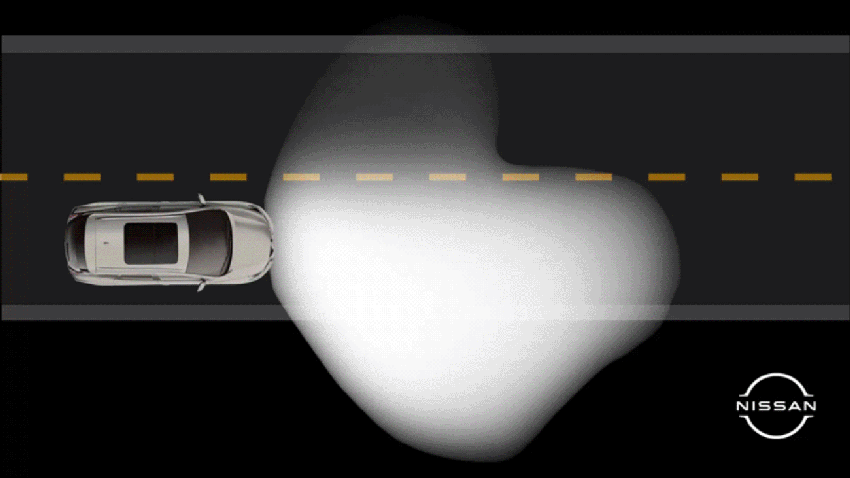
The shaded notch in Nissan's LED headlight pattern avoids dazzling oncoming drivers. NISSAN
The darkest day of the year is just a little brighter this year thanks to improved headlight technology that has been released for U.S. drivers. Nissan points out that the company now has LED headlight technology available for every model in its lineup, and that these lights put more light where it needs to be than ever before.
Just as importantly, precise control of the light means that engineers can avoid letting light go where it can dazzle oncoming drivers. LEDs are about 80 percent more energy efficient and last many times longer than halogen bulbs, explained Brad Chisholm, an engineer on the exterior Lights, Mirrors and Wipers team at Nissan Technical Center North America in Farmington Hills, Michigan.
More importantly, LEDs also allow engineers to design a precise low-beam headlight pattern that both illuminates the road and reduces glare, he added. Creating a light pattern that blacks out a part of the oncoming lane where other drivers could be bothered by the light creates what Nissan terms "anti-glare notch" in the light that makes it easier for oncoming drivers to see without being dazzled by approaching lights. Meanwhile, the strongest, brightest light is aimed toward the lane of travel.
This darkened “notch” area in the light pattern has always been required, but with LEDs, the need to provide it is more critical because the light is brighter. At the same time, LEDs let engineers control the light pattern more precisely because the light source is smaller, said Chisholm.
"We have the ability to carve out that area of the oncoming lane with everything around it being bright and the inside being super dark,"
This is boosted by the ongoing development of LED technology, which continues to shrink the size of the LEDs and their associated electronic modules. Increasingly efficient LEDs mean that their electronics produce less heat that needs to be dissipated. That lets them use smaller heat sinks attached to the module, making the whole unit smaller. “LED shrink allows us to be more robust on our prescriptions on our inner lenses,” Chisholm said. “That allows us to be more precise on where light goes.”
That precision is getting even better thanks to regulatory changes that have finally permitted carmakers to bring active matrix LED lighting to U.S. roads. These headlights turn on and off individual LEDs to let the shaded “notch” move as needed, so that there is no discrete “high” or “low” beam because the lights automatically provide shade when needed for oncoming drivers.
This technology has been held up in a decade-long examination by National Highway Traffic Safety Administration regulators who then abruptly released their approval as part of the Infrastructure Investment and Jobs Act, said Chisholm. This caught carmakers a bit by surprise after so much delay, so Nissan will be bringing its adaptive beam driving headlights to the U.S. Today, Nissan’s most advanced LED light technology is employed in the Ariya EV, the Murano, and the Rogue, but the company hopes to bring the adaptive lighting to U.S. customers soon, Chisholm said.
"That's something I'm stoked about," he said.
TrendForce 2023 Global Automotive LED Product Trend and Regional Market Analysis
Release Date:
1. PDF (166 Pages)- 30 June 2023
2. EXCEL- 30 June 2023 and 31 December 2023
Languages: Traditional Chinese / English
|
If you would like to know more details , please contact:
|












